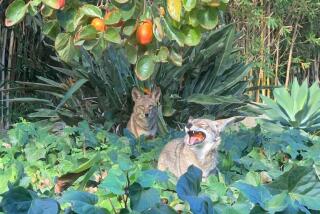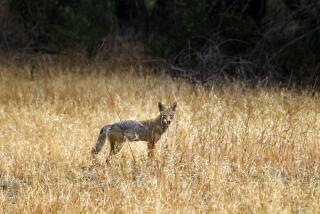Claremont Puts Lid on Coyote Problem by Removing the Temptation--Garbage
- Share via
When William Wirtz II set out to study the habits of coyotes, he had no idea that he would eventually find himself theorizing about the relative merits of garbage can lids in Glendale and Claremont.
However, one topic led to the other for the Pomona College biologist, who presented his ideas about coyotes and municipal sanitation at the recent convention of the American Assn. for the Advancement of Science.
The result is that Claremont officials find themselves reaping unexpected praise for what was part of a labor-saving experiment--using garbage cans with permanently attached lids--which led to de facto wildlife control by making it difficult for coyotes to scavenge through trash.
In Glendale, where a 3-year-old girl was fatally mauled by a coyote in 1981, some officials say they want to look into Wirtz’s ideas.
Hinged Lids
Wirtz’s analysis of coyote droppings and stomach contents of dead animals showed that coyotes in the Glendale area apparently eat about 15 times as much human-generated garbage as do coyotes in Claremont. The tightly fitted, hinged lids on trash cans in Claremont were apparently responsible for the difference.
“I didn’t know this would happen,” Wirtz said. “The only explanation is the difference in the garbage cans. That seems to me to be a reasonable explanation for the data I have.”
He stressed that he is not picking on Glendale, which has taken other steps to discourage coyotes. Like Glendale, most cities allow garbage cans with tops easily dislodged by animals. Claremont began requiring the hinged-topped cans as part of a switch to automated, one-man trash trucks three years ago.
Wirtz wants all foothill cities to know that trying to get rid of coyotes by killing them is “a waste of time, like trying to kill flies around a dead horse.”
Easy Access
Most coyote attacks on household pets and people occur in neighborhoods where coyotes have easy access to food and have lost their innate fear of humans. Because coyotes are so territorial, other coyotes will fill the vacuum left by trapping of the animals in those areas. A better idea is to get rid of what attracted the animals to the area in the first place, Wirtz said.
Besides, he added, slaughtering coyotes could disrupt the ecological balance and cause a population boom in the small animals they eat, such as rabbits, rats and squirrels. Those animals can cause their own share of annoyances and health problems, he said.
The Claremont helped fund Wirtz’s study, but he and city officials emphasize that that had no bearing on his findings. In fact, the study was begun before the new garbage cans were purchased.
Stirs Interest
In Glendale, John Bingham, administrative analyst in the city manager’s office, said Wirtz’s theory “sounds like something we’d be interested in checking out if, indeed, it’s valid.”
He and other officials said problems with coyotes seem to have diminished sharply in recent years as residents follow a city ordinance and use common sense by not feeding coyotes, not leaving food outdoors for pets, not leaving small pets outdoors at night and making sure that food wastes are properly wrapped to conceal odors.
Glendale Police Capt. Thomas Rutkoske said that after the mauling death of 3-year-old Kelly Keen in August, 1981, the city undertook an extensive campaign to educate citizens on how to keep coyotes away.
“In the last three years, we’ve had zero calls about coyotes,” said Rutkoske, who headed the investigation into the child’s death.
Birds of Prey
Wirtz said he never intended to become a coyote expert, let alone one on garbage cans. If anything, his first love is birds of prey, like eagles and great horned owls.
Wirtz became interested in coyotes and their incursion into cities during research about birds and small mammals in the chaparral areas of the Angeles National Forest about 11 years ago.
“I wanted to learn about who ate my mice,” he recalled.
After a number of increasingly brazen coyote intrusions in the area and a non-fatal attack on a 5-year-old girl in nearby La Verne in 1979, Wirtz four years ago persuaded Claremont and the Humane Society of Pomona Valley to contribute a total of $4,000 to his research on urban coyotes.
With that money, he bought a headset receiver and wildlife collars that emit high-frequency radio signals. He and students eventually trapped four coyotes in the Claremont area, put the collars on them and released them. Daily radio tracking found that the coyotes spend their lives within fairly small areas, with one female never seeming to leave an area of three square kilometers.
Cat Fur
The researchers also collected the animals’ droppings. Wirtz said he can pretty much tell what the coyotes ate by seeing what passed through their systems undigested: things like rabbit teeth, cat fur, snake bones, olive pits and aluminum foil.
Wirtz said he included the Glendale area in his study only after the 3-year-old girl was fatally mauled by a coyote in front of her house in the Chevy Chase Canyon area. After the incident, county agricultural agents, using a $5,000 emergency appropriation from the Glendale City Council, sharply increased the trapping and killing of coyotes in Glendale. For a while, that produced a regular flow of carcasses for Wirtz to examine.
He said he was amazed at what the autopsies revealed: “I found guacamole, fast-food wrappers, cottage cheese, pieces of milk cartons. I hadn’t really expected that at all.”
Fruits and Plants
His study indicated that 37% of the diet of Glendale-area coyotes was composed of garbage, with rabbits making up 12%, wild birds 10%, cats 10% and field mice 5%. The rest were insects, reptiles, other birds, fruits and plants.
The analysis of Claremont coyotes’ droppings found their diet to be 21% rabbit, 26% wild and domestic fruits, 11% insects, 10% birds, 4% cats and only 2 1/2% garbage.
More to Read
Sign up for Essential California
The most important California stories and recommendations in your inbox every morning.
You may occasionally receive promotional content from the Los Angeles Times.














